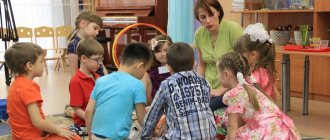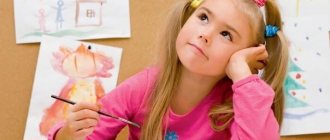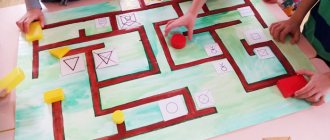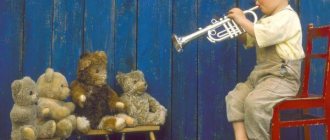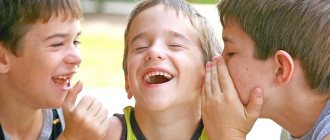What conditions for communication does the game provide for children?
In preschool age, play is the main form of children's activity, the leading activity that stimulates the all-round development of the child. The vast majority of games are designed for partnerships and collective interactions.
If a child wants to express himself in any role, he needs partners; wants to run and jump - needs accomplices in active action.
Such activities involve interaction, communication, communication both with each other and in a group of children.
The game has a set of requirements and characteristics that are directly related to the development of communication.
- The need to establish connections with other children, to communicate something, to ask about something.
- Ability and willingness to work together.
- Opportunities to take the initiative and convince peers to take part in the game or agree with the proposal of a rule, etc.
- Willingness to submit to the demands of the team and change one’s behavior.
- The need to take into account the opinions of others.
- The ability to find your place in the game and communicate during actions.
- Willingness to show attention and emotional support to peers.
- The need to control your behavior, statements, outbursts of emotions.
Communication in a person’s life performs three main functions: information and communication, regulating relationships and ensuring the emotionality of relationships (affective-perceptual). If we analyze the above list, it becomes obvious that for each of the communication functions there is a place for development in the play activities of preschoolers.
Children's play as a medium for the development of all aspects of communication
Let's consider how the conditions of the game provide preschoolers with opportunities to develop communication skills in terms of the basic functions of communication.
Development of information and communication function
If in ordinary conversations children speak without really listening to the other, then the game situation significantly reduces such chaos. A situational business form of communication is emerging.
Whether it is necessary to agree on what game will be played, assign roles or discuss the rules - preschoolers try to listen to the speaker. In a group of children there are always those who interrupt without listening to the end and shout out their suggestions. Other children stop such screamers, ask them to be silent, and order them back: “Let me listen!”
Following the plot, preschoolers strive to perform roles in a way that conveys the nature of the relationship, rather than simply performing actions. Role-playing speech addressed to game partners is actively used. Dialogues often develop between the characters in the plot. This is great communication training.
In older preschool age, the content of the game is often the relationships between people and the rules governing behavior and communication. For example, while pretending to be at school, one of the preschoolers acts as a strict teacher, makes comments to the students, and strictly follows the educational regulations.
Thus, thanks to inclusion in the game, children exchange information, learn a lot of new things, gain experience in effective communication, and have the opportunity to speak out themselves and hear others.
Formation of interaction skills
A preschooler's mastery of the world of relationships largely occurs through imitation of others. The most important practical task for a preschooler is to learn to act together, coordinating his desires and actions with the activities of his peers.
The older the preschooler, the greater his desire to play together. He may even agree to roles that are of little interest to him in order to get involved in collective activities.
It is interesting that other mechanisms then come into play: when choosing a partner within the framework of the plot, children do not want a random choice, but offer to play together with someone with whom they have already established friendly relations or have shown common interests.
As an example, a girl may agree to be not a flight attendant (an attractive role), but a passenger, but at the same time she will invite her friend to be a “passenger”. And only after this will he become much more enthusiastic about playing a role that initially did not arouse much interest.
Plot-based role-playing game creates conditions for children to simultaneously develop role-playing and real-life relationships. In role-playing games they train “as they should,” but in real ones they behave the way they want.
When children speak in accordance with the chosen role, they reflect their ideas about the style and nature of relationships. Every day they see how their parents communicate, how other adults interact, and imitate them in accordance with the game plot.
It is interesting to watch how a preschooler steps out of his role for a minute and begins to express his comments that someone is behaving differently, or that the rules of the game do not correspond to how it happens in life.
Development of the emotional sphere and children’s perception of each other
The situations played out by children are made up for fun, but the feelings experienced in the game are real, real.
In play, a child can express himself in ways that he would not dare to behave in everyday interactions with peers. This is especially true for timid children. Adults who organize or supervise preschoolers’ games should encourage timid children to also take leading roles. This will not only open up the child’s potential, but will also allow other children to see a new side of their peers.
In children's games there is a lot of expression, laughter or violent indignation. The preschooler learns to manage his behavior and emotionality, and masters the moral norms of relationships.
Preschoolers quarrel quite often when playing. Especially at the stage of distributing roles, establishing rules, and developing the plot. The reason for these quarrels is differences in the presentation of actions and the nature of the game. For example, one child believes that their play “store” should copy a self-service supermarket, while another insists that the “salesperson” weighs, accepts “money”, etc.
Those who argue have to compromise and come to an agreement. Otherwise the game will not take place. Moreover, preschoolers resolve such disputes themselves, without turning to adults. This is how they learn to give in, agree with different opinions, cope with resentment, and make their first attempts to analyze their behavior and the actions of other children.
Development of communication skills of children 3 - 4 years old in the process of play activities
Communication games for younger preschoolers in kindergarten
Author: Marina Nikolaevna Kosmacheva, teacher of MBDOU “Kindergarten No. 36”, Arzamas
Description of the material : I offer you a methodological development on the topic “Development of communication skills of children 3-4 years old in the process of play activities.” This material will be useful to teachers of the second younger group. “The lack of communication in preschool age leaves a fatal mark on the subsequent fate of the individual, determining the formation of aggressiveness, antisocial tendencies, and spiritual emptiness in her” (V.V. Davydov)
The task of a modern preschool educational institution is to ensure that pupils emerge from its walls not only with a certain stock of knowledge, skills and abilities, but also independent people, possessing a certain set of moral qualities necessary for later life, the assimilation of social, ethical standards of behavior, interaction with adults and peers.
The most favorable period for a child’s social and communicative development is preschool childhood, because relationships with other people arise and develop most intensively in preschool age. The first experience of such relationships becomes the foundation on which further personal development is built. The subsequent path of his personal and social development, and therefore his future fate, largely depends on how the child’s relationships develop in the first group in his life - the kindergarten group. In preschool pedagogy, the point of view of M. I. Lisina, T. A. Repina, A. G. Ruzskaya prevails, according to which “communication” and “communicative activity” are considered as synonyms. Imi o. Communication is the process of two-way exchange of information leading to mutual understanding. A number of studies note that communication skills contribute to the mental development of a preschooler (A.V. Zaporozhets, M.I. Lisina, A.G. Ruzskaya) and influence the overall level of his activity (Z.M. Boguslavskaya, D.B. Elkonin ). Communication abilities are an important condition for the development of a preschool child, his socialization and individualization, and personality formation. Interpersonal and social relationships between people are realized in communication (B. G. Ananyev, M. M. Bakhtin, A. N. Rubinstein, A. N. Leontyev). Starting from 3-4 years old, a new communication partner appears in a child’s life, which becomes more and more significant with age. This is a peer. The need to communicate with a peer is one of the leading needs of a child in preschool age. This is the most difficult period in the child’s relationship with the team. Most of the problems that arise at this age are to blame for children's selfishness, which is most acute in this age group. At 3-4 years old, a child treats his peers as his own kind, with whom he can have fun. But at the same time, the child does not yet know how to listen to the opinions of other children. For a 3-4 year old child, only his own “I” exists, and he perceives other children not as independent individuals, but as a source of satisfying the needs of his “I” (to play, fight, run, etc.) At the same time, the child sincerely does not understand that other children have their own needs and their own desires. He was used to only dictating his own terms, and not taking into account the desires of others. At 3-4 years old, a child already makes his first friends. But at this age, children often change their preferences. From the age of three to seven, and throughout life, it becomes very important for a person to receive communication and feedback from peers. Parents are often mistaken that these qualities will come to the child on their own. But practice shows that one of the components of the tasks of preschool preparation is precisely the child’s ability to learn to communicate with peers. Communication skills are those abilities that can and should be developed. The development of communication skills in preschoolers is the development of the ability to communicate effectively and successfully interact with the environment. It is based on several personality traits of a preschooler: the desire to interact, the ability to hear and empathize with the interlocutor, resolve complex issues of interaction, and master the rules of effective communication. In other words, we need to teach children the ability to communicate, teach them a culture of communication. And children need to be taught the basics of communication as early as possible, using a variety of methods and techniques. What forms of organizing children's communication
can you offer?
1. Direct educational activities 2. Speech problem situations 3. Conversations 4. Composing stories, fairy tales, riddles 5. Situational conversations 6. Games. I would like to dwell on play activities as one of the most effective forms of interaction between children. Play is the leading activity of a preschool child and the best way to resolve issues in the upbringing and development of a child and the main method of developing communicative abilities, in which the child learns to coordinate his actions with the actions of his partner. Communication is an important element of any game. During the game, the ability to engage in communication and cooperation with each other and with adults is formed. The emotional world of the child is also enriched. Children learn to resolve conflicts, express emotions and interact appropriately with others. Children’s communication abilities increase, serving as one of the parameters of a high level of social competence. Playing in the Federal State Educational Standard acts as a form of socialization of the child. A game is not entertainment, but a special method of involving children in creative activities, a method of stimulating their activity. The social and communicative development of preschool children occurs through play as a leading children's activity. A game is a school of social relations in which forms of child behavior are modeled. The simplest and most effective way to develop communication skills in children of this age category is communicative games. These games are aimed at developing constructive communication skills, the ability to receive joy from communication, the ability to listen and hear another person, the emotional sphere. Communication games are divided into groups:
- games to develop attention and interest in a communication partner;
— games to develop the ability to make contact and conduct dialogue; — games to develop group interaction skills; - games for physical contact. "Aw!" (authors - O. Khukhlaev, O. Khukhlaeva) Goal: development of interest in peers, auditory perception. Number of players: 5-6 people. Description of the game: one child stands with his back to everyone else, he is lost in the forest. One of the children shouts to him: “Ay!” - and the “lost” person must guess who called him. Comment: the game indirectly stimulates children's interest in each other through the game rule. This game is good to use in the process of introducing children to each other. It is easier for a child with his back to everyone else to overcome communication barriers and overcome anxiety when meeting others. “Affectionate name” Goal: to develop the ability to make contact and show attention to peers. Children stand in a circle, passing the baton (flower, “magic wand”) to each other. At the same time, they call each other by an affectionate name (for example, Tanyusha, Alyonushka, Dimulya, etc.) The teacher draws the children’s attention to the affectionate intonation. “Polite words” Goal: development of respect in communication, the habit of using polite words. The game is played with a ball in a circle. Children throw a ball to each other, saying polite words. Use only greeting words (hello, good afternoon, hello, we are glad to see you, we are glad to meet you); gratitude (thank you, thank you, please be kind); apology (sorry, pardon, sorry, sorry); farewells (goodbye, see you later, good night). “Compliments” Goal: develop emotional sensitivity, practice verbal communication skills. Sitting in a circle, everyone joins hands. Looking into your neighbor's eyes, you need to say a few kind words to him, praise him for something. The receiver nods his head and says: “Thank you, I’m very pleased!” Then he gives a compliment to his neighbor, the exercise is carried out in a circle. Some children cannot give a compliment; they need help. Instead of praising, you can simply say “delicious”, “sweet”, “floral”, “milk” word. If a child finds it difficult to give a compliment, do not wait for his neighbor to be sad, give the compliment yourself. “Friendship begins with a smile” Goal: to practice non-verbal communication skills. Children sitting in a circle hold hands, look into their neighbor's eyes and silently smile at each other. “Friends” Goal: to create a sense of unity, cohesion, and the ability to act in a team. Children stand in a circle. 1 verse. Here you are, here I am (stretch your palms forward, then put them on your chest) You can’t quarrel (they shake a finger at the center) Here you are, here I am (stretch your palms forward, then put them on your chest) Together we are friends (take hold of hands) Verse 2 (repeat movements in pairs) Here you are, here I am (stretch your palms forward, then put them on your chest) You can’t quarrel (they shake a finger at each other) Here you are, here I am (stretch your palms forward, then put them on your chest) Together we are friends (hug each other) “Animal Piano” This communicative game was developed by O.V. Khukhlaeva Goal: to develop the ability to cooperate with each other. Children sit in one line (it turns out to be a piano keyboard). The game leader (an adult) gives each child cards with images of animals, whose voices will sound “keys” (cat, dog, pig, mouse, etc.). The presenter, that is, the “pianist,” touches the children’s heads (“plays the keys”). And the “keys” each make their own sound. You can also play on your knees – the keys. Then you can also introduce sound volume into the game. If the pianist touches the key lightly, it sounds very quiet, barely audible, if more strongly, it sounds loud. If it is strong, then the “key” is to speak loudly. Communicative games with movements (active communicative games). This type of games teaches children to listen carefully, correlate movements with music or words, move harmoniously, synchronously, and help achieve coordination and interaction in a team. “The Cheerful Engine” Goals: To develop the cohesion of a group of children, the ability to overcome obstacles together. Progress: The presenter is a “locomotive” who must make a train of children. The guys are assigned the role of “carriages”. The “locomotive” drives up to each of the “cars” in turn and gets acquainted with it. When naming a name, you can ask the guys to come up with one good word for themselves, for example: “I’m the funny little engine Lena, and who are you?” - And I’m a beautiful trailer, Sasha. - Let's move on together. - Go. The children go after the next “car”, and so on until a whole funny train is assembled. Then the children stand one after another and hold the person in front by the belt. In this position, they overcome various obstacles: Get up and get off the chair (“We need to cross the mountains”). Crawl under the table (“We drove into a tunnel”). Make your way through the “dense forest”. Drive quietly through the “enchanted forest” so as not to “fall into the clutches of wild animals.” Throughout the entire exercise, children should not be detached from their partner. The train that arrives at the finish line in full strength is awarded (“The engine and the carriages were very attentive, took care of each other and therefore did not lose anyone along the way”). “Palm to palm” (authors: N. Klyueva, Yu. Kasatki) Goal: developing communication skills, gaining experience interacting in pairs, overcoming the fear of tactile contact. Age: any. Number of players: 2 or more people. Necessary equipment: table, chairs, etc. Description of the game: children stand in pairs, pressing their right palm to their left palm and their left palm to their friend’s right palm. Connected in this way, they must move around the room, avoiding various obstacles: a table, chairs, a bed, a mountain (in the form of a pile of pillows), a river (in the form of a laid out towel or a children's railway), etc. Comment: in this In the game, a couple can be an adult and a child. You can complicate the game if you give the task to move by jumping, running, squatting, etc. Players need to be reminded that they cannot unclench their palms. The game will be useful for children experiencing difficulties in the process of communication. After the games, it is useful to talk with your child about how important speech is for communicating with other people, how important it is to speak correctly. It is advisable to discuss with your child the importance of gestures and facial expressions for the expressiveness of speech. You can talk about those people who talk too much (chatterboxes) and too little (silent people), why we need to talk, whether we know how to listen to others, how to easily hurt with a word. When conducting games and exercises from this section with your child, you need to show him that “body language” (facial expressions, gestures) does not always coincide with what we say in words. For example, when saying something good to another, a person may involuntarily clench his fists, i.e. subconsciously express aggression towards his interlocutor. After the game, it is advisable to discuss its content, find out what happened, whether the child had any difficulties in completing tasks, what he felt and what he wanted at that moment, why conflict situations arose in the game (if any). Formed communication abilities are the most important indicator of a child’s readiness to interact with people around him. They allow children to cope with an unfavorable situation, help overcome timidity and embarrassment, influence the formation of friendly relationships with others, and ensure the success of joint activities (A. V. Zaporozhets, D. B. Elkonin, etc.)
We recommend watching:
Speech support for children of the younger group in role-playing games Educational games and exercises for children 3-4 years old Development of moral and speech qualities of children of primary preschool age through theatrical activities Features of the development of children of primary preschool age
Similar articles:
Educational games for children 3-4 years old in kindergarten
Games to develop communication for preschoolers
Outdoor games for children 3-4 years old in kindergarten
Game activities of children of primary preschool age
Games for learning the seasons with children 3-4 years old
